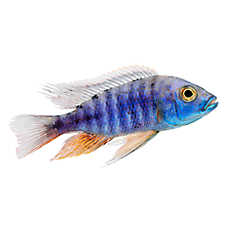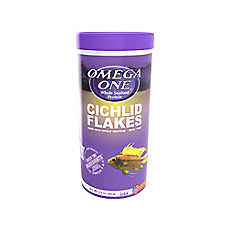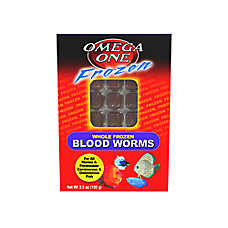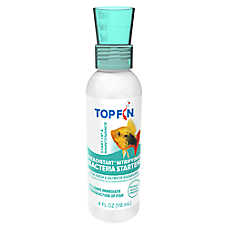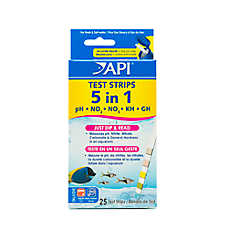Cichlid Care Guide
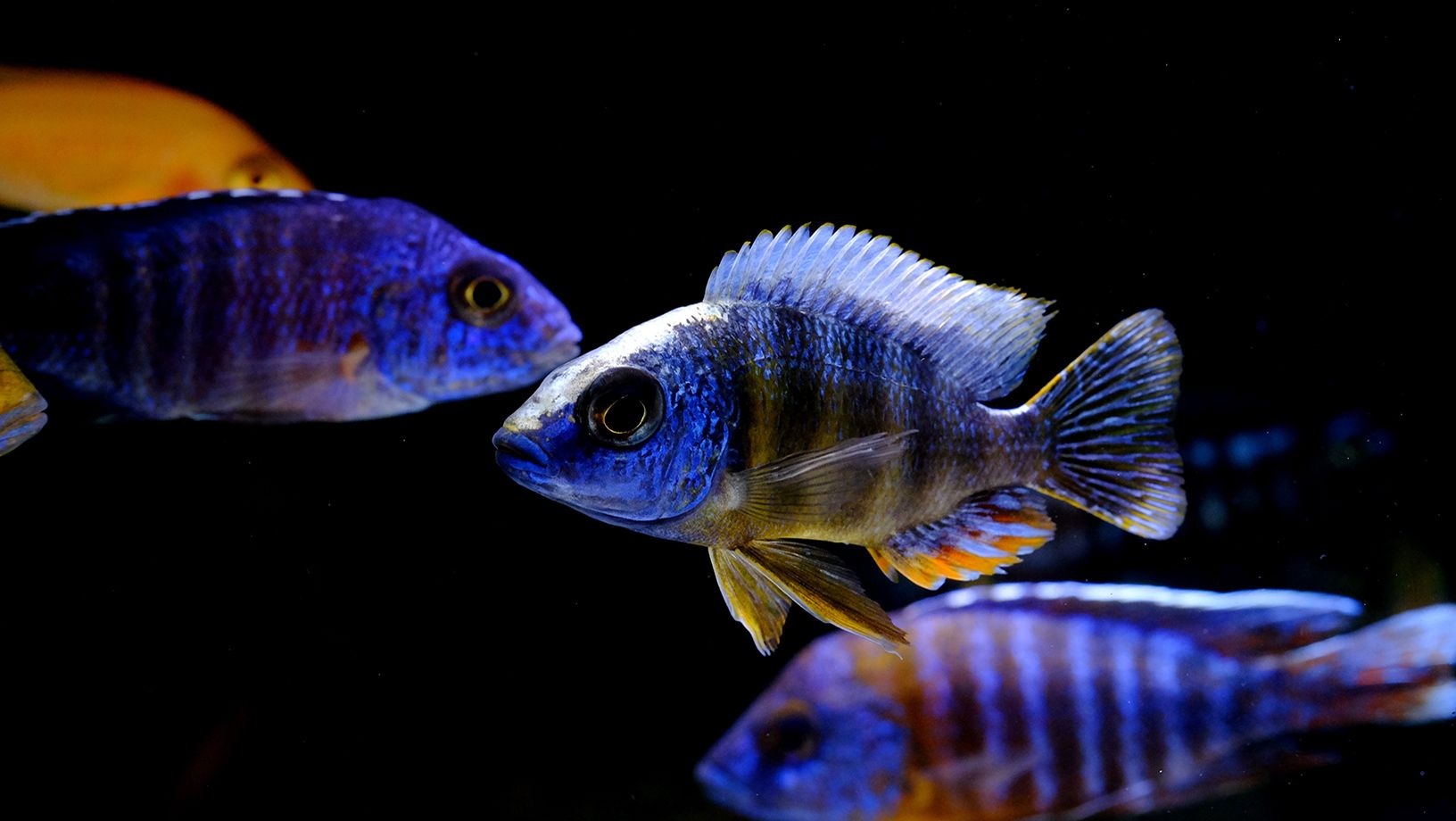
In this Article
Colorful and Territorial
Cichlids are some of the most colorful fish in the hobby with big personalities! Cichlids are a favorite with fish hobbyists for the wide variety of colors, shapes, sizes, and behaviors within this category. They are often more boisterous than community fish and their larger size makes it easier to find your new fish friends in the tank.
The most popular cichlids in the hobby come from Africa, Central America, and South America. These three locations have incredibly fascinating fish, but they shouldn’t be mixed into the same tanks. Cichlids use color changes on their body, becoming pale or more vibrant, to communicate. The African cichlids and Central/South American cichlids use opposite communication styles. Just like in people, this miscommunication can cause stress and aggression when mixing these fish.
There are also differences in their preferred water quality. African cichlids often prefer harder, more alkaline water while South American cichlids often prefer soft, acidic water.
Their behavior is also different with African cichlids more likely to engage in territorial behaviors than most Central and South American cichlids. However, keep in mind this is a broad generalization as each fish has its own personality and territoriality depends on the fish and its habitat. Always be prepared to rearrange or change decorations and remove a fish if aggression is seen. Not sure which species get along? Our Fish Compatibility Guide can help you choose compatible tank mates.
African Cichlids
Fun fact! Many of the approximately 1,200 species are mouth-brooding fish who incubate fertilized eggs in their mouths until the babies (known as fry) are developed enough to survive on their own.
Natural Diets:
CARNIVOROUS CICHLIDS: Small fish and crustaceans.
OMNIVOROUS CICHLIDS: Algae and small crustaceans.
HERBIVOROUS CICHLIDS: Algae and plants.
BEHAVIOR: When keeping fish as pets, there are no guarantees that the fish will get along. You should always monitor your fish for signs of aggression and be prepared to relocate the aggressor from the aquarium. It can also be helpful to rearrange/add decor to create additional territories and hiding places.
Category information tables for African Cichlids
Lake Malawi Omnivorous Cichlid & Lake Victoria Cichlid
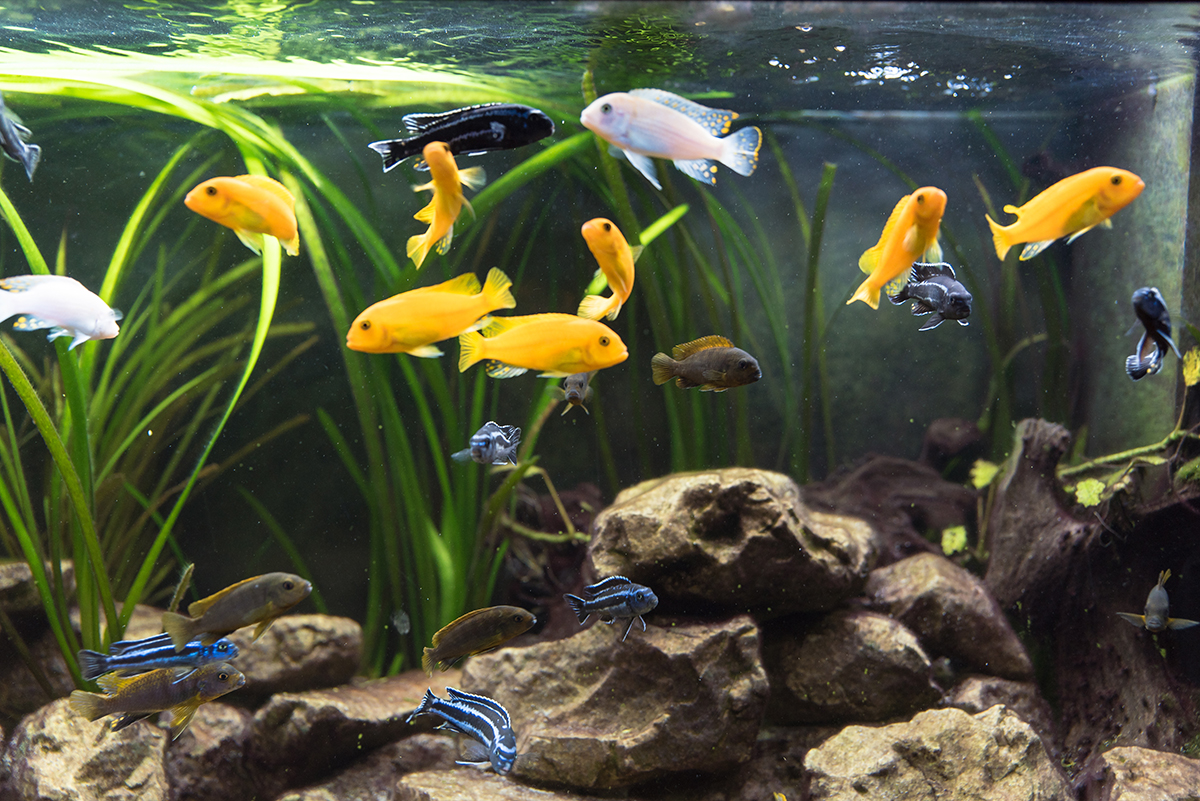
SIZE: Up to 6"
LIFESPAN: 6-8 years, potentially longer in ideal conditions
EXAMPLES: Peacock (Aulonocara spp.), Electric yellow (Labidochromis caeruleus), Assorted African (Pseudotropheus spp.)
TANK SIZE: 50+ gallon
WATER TEMP: 78-80° F (25-26° C)
HABITAT: Natural sand, stacked slate and other natural rocks with enough room for swimming.
SCHOOLING: No. They do well kept with cichlids with similar behavior and diets.
COMMUNITY: Will do well in medium to large aquarium with other omnivorous cichlids from Lakes Malawi and Victoria. Should be kept one male to three females.
FOOD: Cichlid pellets/tropical flakes and vegetable pellets/flakes
Lake Malawi Herbivorous Cichlid
SIZE: Up to 6"
LIFESPAN: 6-10 years, potentially longer in ideal conditions
EXAMPLES: Pseudotropheus demasoni, Maylandia lombardoi, Melanochromis johanni
TANK SIZE: 50+ gallon
WATER TEMP: 78-80° F (25-26° C)
HABITAT: Natural sand, stacked slate and other natural rocks with enough room for swimming.
SCHOOLING: No. They do well kept with cichlids with similar behavior and diets.
COMMUNITY: Will do well in a medium to large aquarium with other herbivorous cichlids from Lake Malawi. Should be kept one male to three females.
FOOD: Vegetable flakes/pellets. (High protein food can be harmful.) While these fish are natural algae grazers, they won't clean algae from the glass or décor
Lake Tanganyika Herbivorous Cichlid
SIZE: Up to 5"
LIFESPAN: 6-10 years, potentially longer in ideal conditions
EXAMPLES: Duboisi (Tropheus duboisi)
TANK SIZE: 50+ gallon
WATER TEMP: 78-80° F (25-26° C)
HABITAT: Natural sand, stacked slate and other natural rocks with enough room for swimming.
SCHOOLING: No. They do well kept with cichlids with similar behavior and diets.
COMMUNITY: These highly territorial fish will do well in a large tank, in groups of at least 12 of the same species to help reduce aggression.
FOOD: Vegetable flakes/pellets. (High protein food can be harmful.) While these fish are natural algae grazers, they won't clean algae from the aquarium glass or décor.
Central & South American Cichlids
Central and South American cichlids are incredibly diverse, with around 650 species of cichlids throughout Central and South America. They come from a variety of freshwater lakes, ponds, streams, and rivers. Due to this diversity, compatibility is species-specific and should be researched prior to selecting tank mates.
Natural Diets:
- LARGE CICHLIDS: Small fish, insects, and crustaceans
- MEDIUM & DWARF CICHLIDS: Insects, crustaceans, and plant matter
Behavior: When keeping fish as pets, there are no guarantees that the fish will get along. You should always monitor your fish for signs of aggression and be prepared to relocate the aggressor from the aquarium. In general, Central & South American cichlids are more peaceful than African cichlids. It can also be helpful to rearrange/add decor to create additional territories and hiding places.
Category information tables for Central and South American Cichlids
Large South American Cichlid
SIZE: Up to 20"
LIFESPAN: 10-15 years, potentially longer in ideal conditions
EXAMPLE: Oscar cichlid (Astronotus ocellatus)
TANK SIZE: 125+ gallon
WATER TEMP: 78-82° F (25-27° C)
HABITAT: Natural gravel and a few large ornaments/rocks.
BEHAVIOR: Aggressive
SCHOOLING: No. They do well kept with cichlids with similar behavior and diets.
COMMUNITY: Will do well housed with 1-2 other large Central/South American fish.
FOOD: Appropriately sized high-protein pelleted fish food. Can be supplemented with frozen food regularly.
Medium South American Cichlid
SIZE: Up to 8"
LIFESPAN: 6-10 years, potentially longer in ideal conditions
EXAMPLE: Turquoise Severum (Heros efasciatus), Blue Acara (Andinoacara pulcher)
TANK SIZE: 50+ gallon
WATER TEMP: 78-82° F (25-27° C)
HABITAT: Natural gravel and heavily planted with live and artificial plants.
BEHAVIOR: Semi-Aggressive
COMMUNITY: Will do well housed with other similarly sized fish with similar behavior.
FOOD: Tropical flake food and appropriately sized frozen natural fish food.
Medium Central American Cichlid
SIZE: Up to 6"
LIFESPAN: 8-10 years, potentially longer in ideal conditions
EXAMPLE: Convict cichlid (Amatitlania nigrofasciata)
TANK SIZE: 55+ gallon
WATER TEMP: 78-82° F (25-27° C)
HABITAT: Natural gravel and a few large ornaments/rocks.
BEHAVIOR: Aggressive
COMMUNITY: Will do well housed with other similarly sized fish.
FOOD: Appropriately sized high-protein pelleted fish food. Can be supplemented with frozen natural fish food occasionally.
Dwarf South American Cichlid
SIZE: Up to 3"
LIFESPAN: 3-10 years, potentially longer in ideal conditions
EXAMPLE: Balloon Ram cichlid (Mikrogeophagus ramirezi)
TANK SIZE: 20+ gallon
WATER TEMP: 78-82° F (25-27° C)
HABITAT: Lower pH, natural gravel and heavily planted.
BEHAVIOR: Peaceful
COMMUNITY: Will do well housed with other appropriately sized fish. These fish tend to do well in heavily planted tanks with other small South American fish.
FOOD: Tropical flake food and appropriately sized frozen natural fish food.
SKILL LEVEL: Advanced
South & Central American Hybrid Cichlid
SIZE: Up to 8"
LIFESPAN: 5-15 years, potentially longer in ideal conditions
EXAMPLE: Blood-Red Parrot cichlid (Heros x Amphilophus), Polar Blue Tiger Parrot cichlid (Cichlidae hybrid)
TANK SIZE: 55+ gallon
WATER TEMP: 78-82° F (25-27° C)
HABITAT: Natural gravel and a few large ornaments/rocks.
BEHAVIOR: Aggressive
COMMUNITY: Will do well housed with 1-2 other large Central/South American fish.
FOOD: Appropriately sized high-protein pelleted fish food. Can be supplemented with frozen natural fish food occasionally
How do I set up a cichlid aquarium?
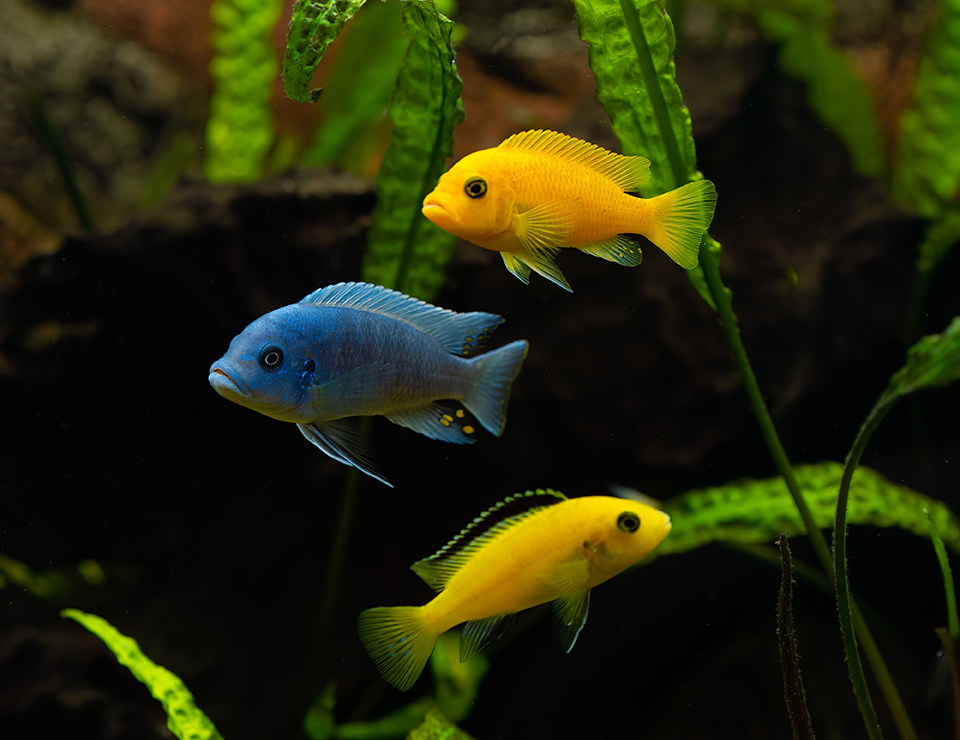
Setting up a healthy environment for your cichlids starts with the right preparation:
- Choose your tank, substrate, décor, and equipment. Ask a PetSmart associate for help selecting items based on your cichlid species.
- Place your aquarium on a flat, stable surface that can support the full weight of the tank (remember: water weighs 8.3 pounds per gallon).
- Rinse all substrate, decorations, and ornaments thoroughly with tap water to remove dust. Never use soap, as it can be harmful to fish.
- Add the rinsed substrate, décor, and ornaments to the tank, arranging to create hiding spaces and territories.
- Fill the tank with tap water, using a water conditioner/dechlorinator to remove harmful chlorine or chloramine. If your home has a water softener, use a tap that bypasses it.
- Install and connect all equipment (heater, filter, thermometer, etc.) according to manufacturer instructions.
- Set up aquarium lighting and a lid or hood. Lights should run about 12 hours per day; use a timer for consistency and remember to turn them off at night.
- Let the system run for 24 hours to stabilize temperature and check that all equipment is working correctly.
- Once conditions are stable, introduce only a few hardy fish to begin cycling your tank. Alternatively, consider a fish-less cycle - learn more in Setting Up an Aquarium.
- Always add a beneficial bacteria starter to support the cycling process.
- Test water daily during cycling and complete a partial water change if Ammonia or Nitrite rises above 0ppm, or Nitrate exceeds 20ppm.
- Always add water conditioner during water changes to protect your fish.
- Once your system is established, quarantine any new fish in a separate, cycled tank for 30 days before adding them to your main aquarium.
- If you plan to add multiple types of fish, check our Fish Compatibility Guide to help you choose compatible species.
African Cichlids Specifics:
- African cichlids from Lake Tanganyika, Lake Malawi and Lake Victoria come from an area with lots of rocky caves. Using rock or decorations to create lots of areas for these fish to move in and out of adds a lot of enrichment and reduces stress and aggression!
Central and South American Specifics:
- Central and Southern American cichlids often come from areas with lots of vegetation and they like lots of driftwood, almond leaves, and robust live plants like Anubias or Sword plants.
- Larger cichlids may dig these up or nibble on them.
When should I test my water quality?
- Fish are sluggish, near the bottom of the tank
- Fish are at the top, breaking the water to breathe
- Fish are not eating
- Sudden behavior changes in your fish
- Water is cloudy
- Water smells funny
PetSmart offers free water quality testing and one of our knowledgeable associates can help you get your system balanced.
When should I contact a veterinarian?
- Contact an aquatic veterinarian if you notice the following signs:
- Unusual swimming pattern
- Thinness or decreased appetite
- Abdominal swelling
- Inflamed or discolored skin/fins
- Fins clamped to sides of body
- Scraping body on rocks (flashing)
- Visible signs of illness or recent fish loss
If your fish show any of the signs above, we recommend using the “Find a Fish Vet” tool at fishvets.org or wavma.org to locate a qualified aquatic veterinarian in your area.
Shopping Checklist
What will I need for my cichlid?
- Aquarium sized appropriately for the species (50-100+ gallon) with stand
- Aquarium hood with light fixture & bulbs
- Natural aquarium sand or gravel and gravel vacuum
- Tank décor like river rock, lace rock, and slate; live or artificial plants
- Aquarium heater and thermometer
- Appropriately sized filter
- Water testing kit or strips
- Water conditioner/dechlorinator
- Beneficial bacteria starter
- Algae cleaning pad or scraper
- Species-appropriate fish food
Ready to learn more?
This guide is a great starting place, but we encourage you to do more research on the individual species that you are keeping so that you can be as successful as possible with your aquarium!
Related guides:
Vet Assured™: Pets purchased at PetSmart are part of our exclusive Vet Assured™ program, designed by PetSmart veterinarians to help improve the health and well-being of our pets. Our vendors meet a high standard in caring for pets and screening them for common illnesses. This program also includes specific standards for in-store pet care.
The PetSmart Promise: If your pet becomes ill during the initial 14-day period, or if you’re not satisfied for any reason, PetSmart will gladly replace the pet or refund the purchase price.
Safety tips for you and your pet:
1. ALL ANIMALS can potentially carry viral, bacterial, fungal, and parasitic diseases contagious to humans. 2. Thoroughly wash your hands with warm, soapy water before and after contact with any pet or its habitat. 3. Adults should assist children with hand washing after contact with a pet, its habitat or aquarium water. 4. Always add a dechlorinator or water conditioner and bacteria starter to tap water before adding it to the aquarium. 5. Do not use soaps or detergents to clean aquarium or decor, since they are toxic to fish. For more information, visit petsmart.com, cdc.gov/healthypets, or contact your veterinarian.
This care guide contains general information for the proper care of your pet, but is not comprehensive and is not a substitute for veterinary advice or care. PETSMART and VET ASSURED are trademarks of PetSmart Home Office, Inc. © 2025 PetSmart. All rights reserved.
The PetSmart Promise: If your pet becomes ill during the initial 14-day period, or if you’re not satisfied for any reason, PetSmart will gladly replace the pet or refund the purchase price.
Safety tips for you and your pet:
1. ALL ANIMALS can potentially carry viral, bacterial, fungal, and parasitic diseases contagious to humans. 2. Thoroughly wash your hands with warm, soapy water before and after contact with any pet or its habitat. 3. Adults should assist children with hand washing after contact with a pet, its habitat or aquarium water. 4. Always add a dechlorinator or water conditioner and bacteria starter to tap water before adding it to the aquarium. 5. Do not use soaps or detergents to clean aquarium or decor, since they are toxic to fish. For more information, visit petsmart.com, cdc.gov/healthypets, or contact your veterinarian.
This care guide contains general information for the proper care of your pet, but is not comprehensive and is not a substitute for veterinary advice or care. PETSMART and VET ASSURED are trademarks of PetSmart Home Office, Inc. © 2025 PetSmart. All rights reserved.

